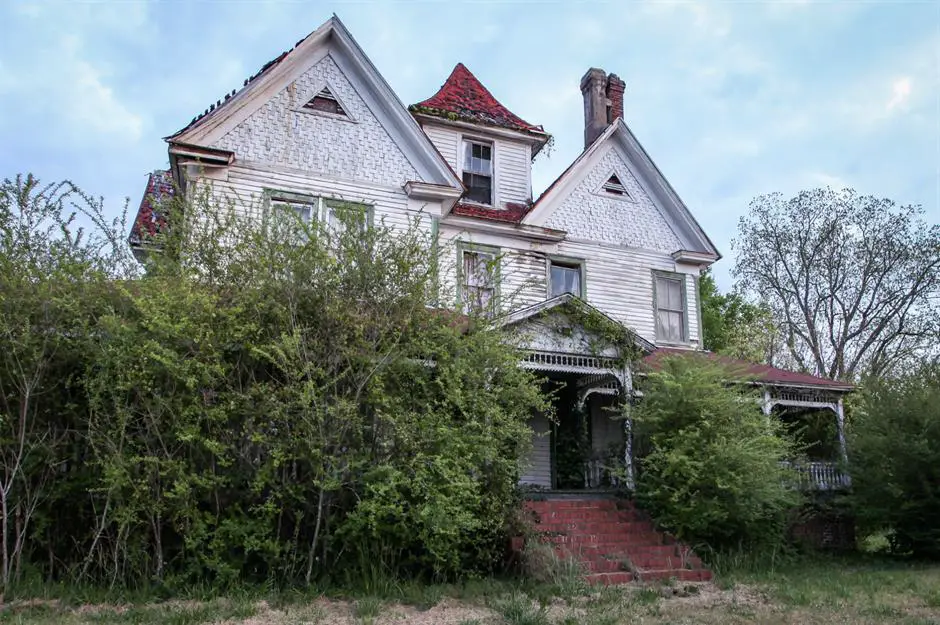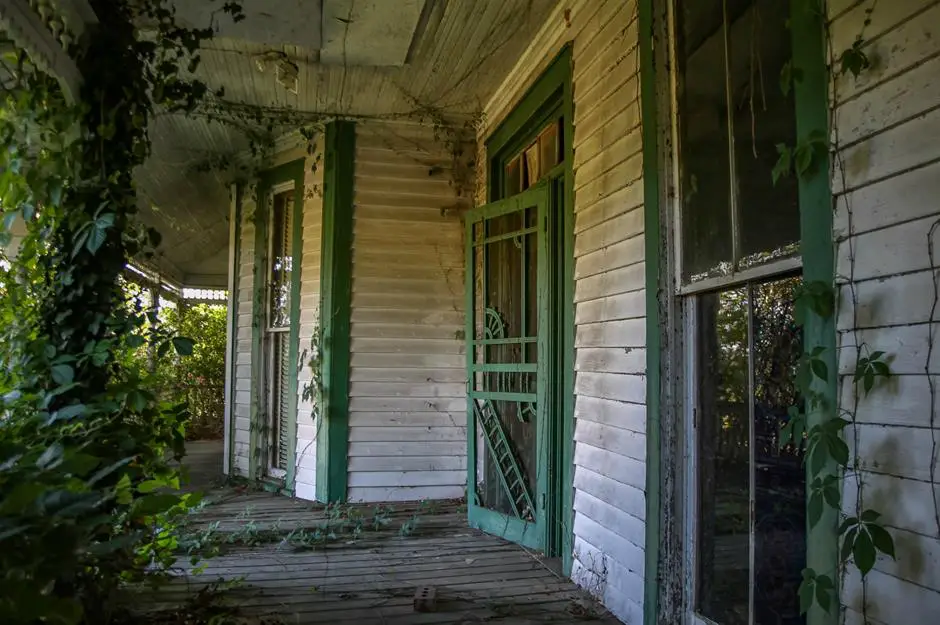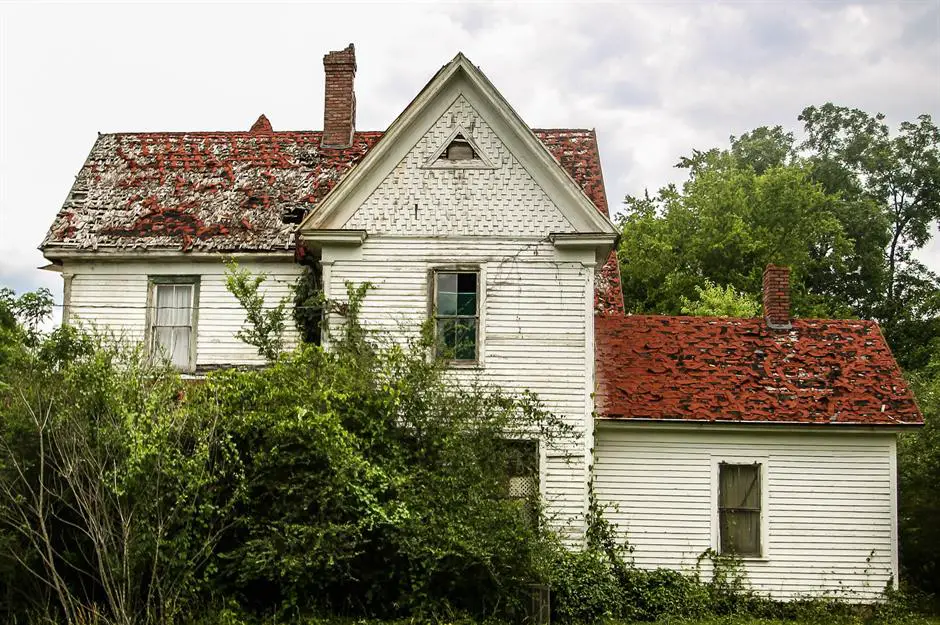Nestled in a wooded lot and shrouded in foliage, this intriguing property in Georgia has quite the tale to tell. The early 20th-century property changed hands multiple times before being purchased by Mr. John McCown in 1967, a figure both revered and reviled, who played a pivotal role in shaping the region’s history.
Reclaimed by nature

Neglect has taken its toll on the property, evident from the derelict facade. The once-imposing central turret has begun to crumble, and several windows are missing panes of glass. Nature has reclaimed the structure, with vegetation encroaching on the ground floor and foliage clinging to the porch roof.
Faded grandeur

Inside, the story mirrors the exterior. Parts of the ceiling are collapsing, and the walls are covered in black mold. Nevertheless, the house retains hints of its former grandeur. Elegant tongue-and-groove paneling remains remarkably well-preserved, and the intricate parquet ceiling attests to the wealth of its previous occupants.
An intriguing past

John McCown, born in South Carolina in 1934 and raised in Harlem, was a polarizing figure. By the time he purchased the property in 1967, he was already a key figure in the black civil rights movement, having led the first-ever civil rights demonstration in Colorado Springs, Colorado, and worked with the Congress of Racial Equality (CORE).
Decor from days gone by

The faded decor in the living room offers insight into McCown’s tastes. The blue and red paisley wallpaper, bold by today’s standards, was fashionable in the ’70s. The fireplace has been bricked up, but the mantel retains its original glory, lacquered to a glossy sheen and adorned with haut-relief carvings and a beveled glass mirror.
Relocating to Hancock County

McCown moved into the property at 33 when he relocated to Hancock County to assist with the registration of black voters, taking on the role of executive director of the Georgia Council on Human Relations. At the time, about half of the black population in the region lived below the poverty line, making it one of the poorest areas in the United States.
Progress at last

In the early 1970s, McCown founded the Eastern Central Committee for Opportunity (ECCO), aiming to improve the livelihoods of black people in Hancock County. Within a few years, the committee had received millions of dollars in private and federal aid, and with McCown’s help, Hancock County became the only region in Georgia to elect a black-majority board of county commissioners.
Ornate period features

Adorned with ornate features, the abandoned house still reflects McCown’s wealth. Over the years, McCown allegedly acquired many more properties and hundreds of acres of land. The white-painted staircase, with intricately carved balusters and newels, stands out as a well-preserved architectural feature.
Old meets new

On the upstairs landing, several open doorways lead to the property’s bedrooms. Light filters in through heavy, partially closed curtains, casting eerie shadows on the dusty floorboards. McCown’s decor choices are evident, from floral prints with contrasting borders to more contemporary graphic pastel stripes.
Derelict bedroom

One room, possibly McCown’s, contains few personal effects. A chest of drawers stands in front of a window, accompanied by a metal chair with leather upholstery and a bunch of red flowers. Broken china fragments dot the floor, and a strip of wallpaper lies crumpled.
Empty spaces

Another room, cleared of debris, is furnished with a solitary chair. Wood-effect paper, popular in the 1970s, lines the walls. Sunlight filters through gauzy white curtains, creating a golden glow.
The arms race

Racial tensions in Hancock County escalated during the late ’60s and early ’70s. The white mayor of Sparta reportedly purchased submachine guns to intimidate the black population. In response, black officials ordered more firearms, with McCown allegedly encouraging African Americans to do the same.
A piece of history

Georgia Governor Jimmy Carter was drafted in as a mediator to halt the escalating “arms race.” These walls likely witnessed late-night meetings between McCown and his political allies during this turbulent time.
Overgrown veranda

The veranda is obscured by a thick layer of vegetation. McCown would have once paced these boards, contemplating his next moves as he surveyed the property’s extensive gardens.
Decorative balconies

The front of the house reveals ornate wraparound verandas, common features of early 20th-century homes designed for shade in the summer. Elaborately carved posts, balusters, and brackets suggest the homeowner’s wealth.
Scandal in Hancock

McCown’s downfall began with financial allegations. In 1974, The Atlanta Constitution questioned his authority to run ECCO, alleging the redirection of poverty funds for personal use. An internal audit revealed “questionable” costs, leading to a federal grand jury investigation.
Secrets buried in the garden

Outside, the grounds are in better shape than the house. A small clearing, surrounded by box hedges, holds a mysterious stone block.
McCown’s final resting place

John McCown passed away in a plane crash in 1976 at the age of 41. His death didn’t halt the trial, which eventually led to the conviction of five ECCO members. While significant strides were made in Hancock County, ECCO’s reputation suffered.
An enduring legacy

The house stands as a reminder of John McCown’s work in Hancock County, where he contributed to the civil rights movement in the United States. While the abandoned house crumbles, his legacy lives on.